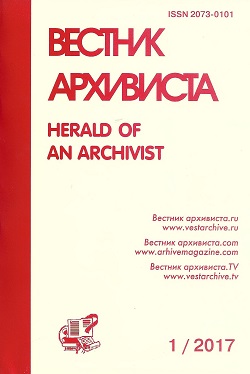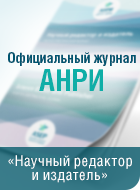Great Seal of Tsar Alexey Mikhailovich (1667): 350th Anniversary of the Coat of Arms of the Tsardom of Muscovy



УДК 94(47).047+929.651
DOI 10.28995/2073-0101-2017-4-147-158
Evgeniy V. Pchelov
Russian State University for the Humanities, Moscow, Russian Federation
Great Seal of Tsar Alexey Mikhailovich (1667): 350th Anniversary of the Coat of Arms of the Tsardom of Muscovy
Abstract
The article analyzes the great seal of Muscovy of 1667; the image on this seal was called a coat of arms for the first time in Russian history. Creation of a new coat of arms coincided with the war’s end and the conclusion of the Truce of Andrusovo with Rzeczpospolita. Still while at war, the Royal title had been changed, incorporating new elements. Thus, the title reflected the annexation of new lands, primarily, those of "Small" and "White" Russia. However, this last part of the title that indicated the wide scale of the Moscow Tsar’s power went back to late 16th century and came from seeing territorial acquisitions as historical heritage recovery. The 1667 coat of arms emerged promptly following the Pereyaslav Council of 1654, but it was after the war that it was finalized. It was the Royal title that determined structure and interpretation of the coat of arms. Heraldic composition is unified, its description may be called the first blazoning in the history of Russian state heraldry. The composition can be divided in three parts. Its central element is double-headed eagle with outstretched wings grasping in the dexter claw a scepter, and in the sinister claw an orb; the eagle is charged on the breast with an escutcheon with an image a rider armed with a spear striking at a dragon; the eagle is crowned with three crowns. The eagle is flanked on three sides by three groups of three emblems: three crowns above, three towns to the left, three towns to the right. These threes correlate with North, East, and West. It is difficult to say what the seven stars mean; these, although not represented in the official blazoning, kept reappearing. The stars had random number of rays (4 to 8 in various versions of the coat of arms), but their total number could have some symbolic meaning. The starry heaven represented by the stars could represent universal nature of the Russian stardom, the Orthodox empire, the eternal Rome in its true, Orthodox form. The new coat of arms of Muscovy endured half a century; it was a turning point in evolution of Russian state symbols.
Download the article: pchelov_doi
Keywords
Heraldry, the state coat of arms, the state seal, the title of Tzar, state symbols.
References
KAMENTSEVA, E. I., USTYUGOV, N. V. Russkaia sfragistika i geral’dika [Russian sphragistics and heraldry. In Russ.]. Мoscow, 1963, 223 p.
KASHTANOV, S. M. Sostav i soderzhanie dokumentov “grecheskikh” posol’skikh knig № 1 i 2 [Composition and contents of documents in "Greek" ambassadorial books 1 and 2. In Riss.] IN: Rossiya i grecheskii mir v XVI veke. T. 1 [Russia and the Greek world in the 16th century. Vol. 1. In Russ.]. Moscow, 2004, pp. 8–40.
Polnoe sobranie zakonov Rossiiskoi imperii. Pervoe. T. 1 [Complete collection of laws of the Russian Empire. Collection 1. Vol. 1. In Russ.]. St. Petersburg, 1830, 1029 p.
PCHELOV, E. V. Izmeneniya gosudarstvennogo gerba Rossii v XVI–XVII v. i ikh prichiny [Changes of state coat of arms of Russia in the 16th – 17th century and their causes. In Russ.] IN: Drevnyaya Rus’: voprosy medievistiki [Ancient Rus: Issues of medieval studies. In Russ.], no 3 (61), 2015, pp. 101–102.
PCHELOV, E. V. Storony sveta v titul’noi reprezentatsii vlasti russkikh gosudarei [Compass points in titular representation of the power of Russian rulers. In Russ.] IN: Istoricheskaya geografiya: prostranstvo cheloveka vs chelovek v prostranstve. Materialy XXIII Mezhdunarodnoi nauchnoi konferentsii [Historical geography: Space of man vs man in space. Materials of the 23rd international scientific conference. In Russ.]. Moscow, 2011, pp. 110–114.
Snimki drevnikh russkikh pechatei. Vyp. 1 [Pictures of ancient Russian seals. Issue 1. In Russ.]. Moscow, 1880, 126 p.
Sobranie gosudarstvennykh gramot i dogovorov. Ch. 4 [Collection of state charters and treaties. Part 4. In Russ.]. Moscow, 1826, 656 p.
KHOROSHKEVICH, A. L. Gerb [Coat of arms. In Russ.] IN: Gerb i flag Rossii. X–XX veka [The coat of arms and the flag of Russia. 10th – 20th century. In Russ.]. Мoscow, 1997, pp. 16–376.
Tsarskii titulyarnik. T. 2 [Tsar's Book of Titles. Vol. 2. In Russ.]. Moscow, 2007, 194 p.
ESKIN, YU. M. Titulyarnik – teksty i illyustratsii [Titulyarnik – the texts and illustrations. In Russ.] IN: Tsarskii titulyarnik. T. 2 [Tsar's Book of Titles. Vol. 2. In Russ.]. Moscow, 2007, pp. 12–33.
About author
Pchelov Evgeniy Vladimirovich, PhD in History, associate professor, Russian State University for the Humanities, department of special and auxiliary sciences of history, head of department, Moscow, Russian Federation, +7-905-581-81-76, This e-mail address is being protected from spambots. You need JavaScript enabled to view it
Submitted 27.04.2017, published:
PCHELOV, E. V. Gosudarstvennaya pechat' Alekseya Mikhailovicha 1667 g.: k 350-letiyu gerba Moskovskogo tsarstva [Great Seal of Tsar Alexey Mikhailovich (1667): 350th Anniversary of the Coat of Arms of the Tsardom of Muscovy]. IN: Vestnik arhivista / Herald of an Archivist, 2017, no. 4, pp. 147-158.











